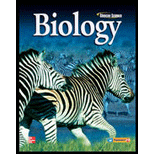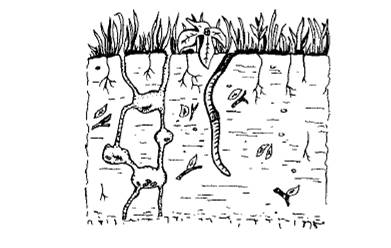
(a)
To explain:
The portions of nitrogen biogeochemical cycle that is related to the diagram.
Introduction : Plants obtain the nutrients from soil, water and air which are then converted to various organic compounds. The nutrients flow through different organisms in the ecosystem.The exchange of matter through the biosphere is called biogeochemical cycle. Nitrogen cycle is one such biogeochemical cycle in which nitrogen is recycled from atmosphere into compounds that can be used by plants.
(a)
Answer to Problem 11STP
In the given diagram it is seen that some organisms are living in the soil. There are root nodules present in the plants. Some bacteria live in soil, water and in plant root nodules. They capture the nitrogen from air and convert it to compounds that are useful to plants. In this way they fix atmospheric nitrogen. Soilbacteria and other decomposers decompose the dead organisms and transform the nitrogen in proteins and other compounds into ammonia.Organisms present in soil convert fixed nitrogen compounds back into nitrogen gas which are released into the atmosphere.
Explanation of Solution
Nitrogen cycle is a continuous process during which nitrogen is converted to nitrates and other compounds and is used and reused by plants and animals. Nitrogen is cycled continuously through the biosphere. The cycle involves nitrogen fixation, ammonification and denitrification.
Plants and animals cannot use nitrogen directly from the atmosphere. Some bacteria that live in soil, water and in plant root nodules capture the nitrogen from air and convert it to compounds that are useful to plants. This process is called nitrogen fixation.
Ammonification- It is a process during which the soil bacteria and decomposers decompose the dead organisms and transform the nitrogen in proteins and other compounds into ammonia.Denitrification- This is the end process in nitrogen cycle. Organisms present in soil convert fixed nitrogen compounds back into nitrogen gas which escapes into the atmosphere.
A complete nitrogen cycle occurs in this ecosystem. All three processes; nitrogen fixation, ammonification and denitrification related to nitrogen biogeochemical cycle happens inside the soil.
(b)
To explain:
The portions of oxygen biogeochemical cycle that is related to the diagram given below
Introduction : Plants obtain the nutrients from soil, water and air which are then converted to various organic compounds. The nutrients flow through different organisms in the ecosystem.The exchange of matter through the biosphere is called biogeochemical cycle. Oxygen cycle is an important biogeochemical cycle because oxygen is important to many life processes.
(b)
Answer to Problem 11STP
In the given diagram, there are green grasses growing in the soil. There are three main stages of oxygen cycle:
- During photosynthesis, the green grasses give out oxygen into the air.
- The animals like worms living in the soil take in oxygen trapped between soil particles for
cellular respiration . - The decomposers release oxygen from dead organic matter back into the soil and air. Hence the cycle of oxygen is complete.
Explanation of Solution
Oxygen cycle is very important for living organisms. All living beings need oxygen to carry out cellular processes. Green plants release oxygen during the day time as a by- product of photosynthesis. The worms and other small animals living in the soil take in oxygen during daytime for cellular respiration. Some amount of oxygen is also taken by plants for respiration. There are decomposers also found in the soil which decompose the dead and decaying organic matter and release oxygen back to the oil and atmosphere. So, there is a balance of oxygen between the atmosphere, lithosphere and the biosphere.
The oxygen cycle is interconnected with the cycle of carbon. Oxygen moves from the atmosphere to the biosphere to the lithosphere.
(c)
To explain:
The portions of carbon biogeochemical cycle that is related to the diagram.

Introduction : Plants obtain the nutrients from soil, water and air which are then converted to various organic compounds. The nutrients flow through different organisms in the ecosystem.The exchange of matter through the biosphere is called biogeochemical cycle. Carbon cycle is one such biogeochemical cycle in which carbon is recycled from atmosphere into compounds that can be used by plants to release energy.
(c)
Answer to Problem 11STP
In the given diagram we can see some organisms living in the soil. During photosynthesis green plants use carbon dioxide from the atmosphere to form carbohydrates and release oxygen back into air. The carbohydrates are used as a source of energy by other organisms in the food web. They respire and release CO2 back to the air.Carbon is also trapped in fossil fuels for millions of years before they are released by burning of fuels. When the plants and animals die, the decomposers decay the organic matter and release the carbon back into the atmosphere.
Explanation of Solution
Carbon cycle is a continuous process during which carbon is converted to carbohydrates and other compounds and is used and reused by plants and animals. Carbon is cycled continuously through the biosphere. The cycle involves the following stages:
- Green plants taken in carbon dioxide from the atmosphere during photosynthesis.
- These plants are consumed by animals living in the soil. The carbohydrates provide energy to all the animals in the food chain of soil.
- Carbon is recycled when autotrophs and heterotrophs release it back to the air during cellular respiration.
- Some carbon enters the long term cycle when organic matter in the soil gets buried underground and is converted to peat, coal, gas and oil deposits. This remain as fossil fuel for millions of years.
- Organisms present in soil decompose dead organic matter and release carbon back to the atmosphere.
Carbon cycle is one such biogeochemical cycle in which carbon is recycled as carbohydrates and carbon dioxide. The carbon cycle is interconnected with the cycle of oxygen. Carbon moves from the atmosphere to the biosphere to the lithosphere and to hydrosphere.
Chapter 2 Solutions
Glencoe Biology (Glencoe Science)
Additional Science Textbook Solutions
Biological Science (6th Edition)
Campbell Biology in Focus (2nd Edition)
Biology: Life on Earth (11th Edition)
Microbiology: An Introduction
Applications and Investigations in Earth Science (9th Edition)
Chemistry: Structure and Properties (2nd Edition)
- What are the structure and properties of atoms and chemical bonds (especially how they relate to DNA and proteins).arrow_forwardThe Sentinel Cell: Nature’s Answer to Cancer?arrow_forwardMolecular Biology Question You are working to characterize a novel protein in mice. Analysis shows that high levels of the primary transcript that codes for this protein are found in tissue from the brain, muscle, liver, and pancreas. However, an antibody that recognizes the C-terminal portion of the protein indicates that the protein is present in brain, muscle, and liver, but not in the pancreas. What is the most likely explanation for this result?arrow_forward
- Molecular Biology Explain/discuss how “slow stop” and “quick/fast stop” mutants wereused to identify different protein involved in DNA replication in E. coli.arrow_forwardMolecular Biology Question A gene that codes for a protein was removed from a eukaryotic cell and inserted into a prokaryotic cell. Although the gene was successfully transcribed and translated, it produced a different protein than it produced in the eukaryotic cell. What is the most likely explanation?arrow_forwardMolecular Biology LIST three characteristics of origins of replicationarrow_forward
- Molecular Biology Question Please help. Thank you For E coli DNA polymerase III, give the structure and function of the b-clamp sub-complex. Describe how the structure of this sub-complex is important for it’s function.arrow_forwardMolecular Biology LIST three characteristics of DNA Polymerasesarrow_forwardMolecular Biology RNA polymerase core enzyme structure contains what subunits? To form holo enzyme, sigma factor is added to core. What is the name of the structure formed? Give the detailed structure of sigma factor and the function of eachdomain. Please help. Thank youarrow_forward
- Molecular Biology You have a single bacterial cell whose DNA is labelled with radioactiveC14. After 5 rounds of cell division, how may cells will contain radioactive DNA? Please help. Thank youarrow_forward1. Explain the structure and properties of atoms and chemical bonds (especially how they relate to DNA and proteins). Also add some pictures.arrow_forward1. In the Sentinel Cell DNA integrity is preserved through nanoscopic helicase-coordinated repair, while lipids in the membrane are fortified to resist environmental mutagens. also provide pictures for this question.arrow_forward
 Human Anatomy & Physiology (11th Edition)BiologyISBN:9780134580999Author:Elaine N. Marieb, Katja N. HoehnPublisher:PEARSON
Human Anatomy & Physiology (11th Edition)BiologyISBN:9780134580999Author:Elaine N. Marieb, Katja N. HoehnPublisher:PEARSON Biology 2eBiologyISBN:9781947172517Author:Matthew Douglas, Jung Choi, Mary Ann ClarkPublisher:OpenStax
Biology 2eBiologyISBN:9781947172517Author:Matthew Douglas, Jung Choi, Mary Ann ClarkPublisher:OpenStax Anatomy & PhysiologyBiologyISBN:9781259398629Author:McKinley, Michael P., O'loughlin, Valerie Dean, Bidle, Theresa StouterPublisher:Mcgraw Hill Education,
Anatomy & PhysiologyBiologyISBN:9781259398629Author:McKinley, Michael P., O'loughlin, Valerie Dean, Bidle, Theresa StouterPublisher:Mcgraw Hill Education, Molecular Biology of the Cell (Sixth Edition)BiologyISBN:9780815344322Author:Bruce Alberts, Alexander D. Johnson, Julian Lewis, David Morgan, Martin Raff, Keith Roberts, Peter WalterPublisher:W. W. Norton & Company
Molecular Biology of the Cell (Sixth Edition)BiologyISBN:9780815344322Author:Bruce Alberts, Alexander D. Johnson, Julian Lewis, David Morgan, Martin Raff, Keith Roberts, Peter WalterPublisher:W. W. Norton & Company Laboratory Manual For Human Anatomy & PhysiologyBiologyISBN:9781260159363Author:Martin, Terry R., Prentice-craver, CynthiaPublisher:McGraw-Hill Publishing Co.
Laboratory Manual For Human Anatomy & PhysiologyBiologyISBN:9781260159363Author:Martin, Terry R., Prentice-craver, CynthiaPublisher:McGraw-Hill Publishing Co. Inquiry Into Life (16th Edition)BiologyISBN:9781260231700Author:Sylvia S. Mader, Michael WindelspechtPublisher:McGraw Hill Education
Inquiry Into Life (16th Edition)BiologyISBN:9781260231700Author:Sylvia S. Mader, Michael WindelspechtPublisher:McGraw Hill Education





